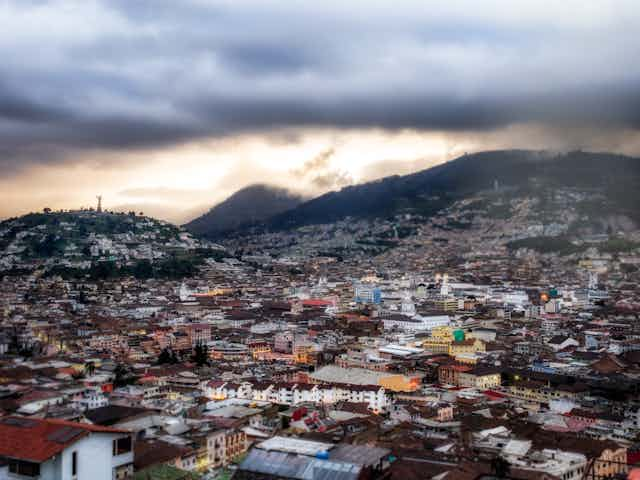Next week, the city of Quito, Ecuador, plays host to the third ever United Nations conference on housing and sustainable urban development – also known as Habitat III. At this four-day international gathering, nation states are expected to agree on the New Urban Agenda, which will set out a global strategy on sustainable urban development for the next 20 years.
What is it?
The Habitat process was launched by the UN in 1976, when governments began to recognise the risks of rapid urbanisation: in particular, rising inequality, falling quality of life and unsustainable development.
The first conference, held in Vancouver, encouraged governments to adopt a territorial approach to their national development strategies, and to involve civil society organisations focusing on urban issues. It also established the first UN agency to be based in Africa: the United Nations Centre for Human Settlements – operated from Nairobi, Kenya – formed the foundation for the UN Programme on Human Settlements, or UN Habitat.
The second conference, held in Istanbul in 1996, was much bigger. It involved representatives from civil society in UN working groups, and produced a 229-page Habitat Agenda. Nation states in the Habitat II process endorsed the “the universal goals of ensuring adequate shelter for all and making human settlements safer, healthier and more liveable, equitable, sustainable and productive”.
Why does it matter?
More than half of the world’s population now lives in urban areas, and this figure is predicted to rise to almost 70% by 2050. As a result, cities have become focal points for addressing many of humanity’s greatest challenges. Economic inequalities have dramatically increased, and are heavily concentrated in urban areas: almost one third of city-dwellers live in informal settlements, such as slums.

Cities are also responsible for 70% of global CO₂ emissions and two thirds of the world’s energy consumption, making them big contributors to climate change. And coastal human settlements are particularly vulnerable to natural disasters.
In recent times, the international community has made several important global agreements, all of which emphasise the significance of urbanisation. It’s seen as both a challenge, and an opportunity to implement the UN’s 17 new Sustainable Development Goals (SDGs), one of which specifically focuses on creating sustainable cities and communities.
Who’s going?
Habitat is a state-led process, so many world leaders and UN representatives will be at the conference. The UN also established a General Assembly of Partners to encourage the participation of local authorities, grassroots and indigenous organisations, women’s and youth groups, as well as the private and charitable sectors.

What’s more, experts from all around the world were invited to make recommendations for the NUA, through ten policy units. These groups examined a range of intersecting issues, including local government finance and urban ecology. Meetings and preparatory committees have been happening since 2014, in anticipation of the main event.
What’s on the agenda?
The main topic of discussion will be the Zero Draft of the New Urban Agenda (NUA): a 24-page document, which outlines the nation states’ shared vision for a sustainable urban future. The NUA has undergone three rounds of revisions between May and September 2016, to iron out conflicts and reach a consensus between the UN nation states.
First and foremost, the draft emphasises the leading role of national governments in setting up national urban strategies. At a time when mayors are rising to prominence as key leaders on the international stage, the draft does not explicitly mention what role these city leaders might play when it comes to implementing the NUA.

The draft also stresses the need to include local authorities, community and grassroots organisations and the private sector in urban development “when appropriate”, without providing much detail about when and how this might be.
The controversial “right to the city” is also enshrined in the document, calling on governments to create “cities for people, not for profit”, ensuring an inclusive, gender and age sensitive approach to city planning, as well as continuing efforts to reduce urban poverty.
Will it work?
Unlike the Paris climate agreement or the SDGs, the NUA is non-binding – it merely provides guidelines for those involved in urban development. There is a notable lack of practical advice about how the NUA should be carried out, and who is in charge of implementing it. The draft does recognise the need for producing evidence to inform the implementation of the NUA, but does not indicate how cities’ progress should be measured and assessed.
There needs to be adequate information and monitoring systems to provide relevant city-level data on key outcomes, such as levels of inequality and carbon emissions. And many nations still need to skill up planners to help with these efforts: according to the 2016 World Cities Report, there are 38 planners for 100,000 inhabitats in the UK, compared with 1.44 in Nigeria and just 0.23 in India – two of the fastest-growing parts of the world.
In cities around the world, ordinary citizens, local leaders, civil society groups, community organisations, the private and charity sectors are already addressing global challenges. Good intentions will reach a dead end without proper financing schemes and efficient national urban strategies, which distribute skills and resources across sectors and levels of government.
The extent to which the NUA can pave the way to sustainable, inclusive and resilient urban futures remains uncertain. Outcomes will heavily depend on the willingness and capacity of governments and actors at every level to implement strategies that effectively address the global challenges we face; from climate change and rising inequality, to food security and displacement.
This is the first in a series of articles on publicly funded UK research at the UN Habitat III summit in Quito, Ecuador. It is a collaboration between the Urban Transformations Network, UK Economic and Social Research Council (UT-ESRC) and The Conversation.

